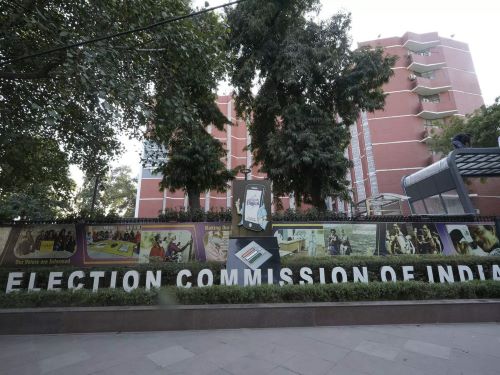Context-
The Election Commission of India (ECI) has been a cornerstone of India's democratic journey, evolving significantly over its 74-year history. Established in 1950 with Sukumar Sen as its first Chief Election Commissioner (CEC), the ECI faced monumental challenges during the nascent stages of Indian democracy. Here's an in-depth look at the pivotal milestones in the ECI's evolution:
Pioneering the First General Election
In 1951-52, India conducted its first general election, a monumental event considering the country's vast illiterate population and rudimentary infrastructure. Despite these challenges, 17.5 crore Indians exercised their voting rights, setting the stage for democratic governance. The process involved extensive logistical planning, with 53 registered political parties contesting over 68 phases.
During this period, electoral procedures were rudimentary, relying on basic means of communication like letters and postcards. The ECI under Sen's leadership navigated through uncharted waters, laying the foundation for subsequent electoral practices.
Expansion of Electoral Processes: Post the first general election, the ECI continued to refine its procedures. The introduction of ballot papers in place of individual coloured ballot boxes for each candidate marked a critical transition towards standardized voting practices. This shift facilitated a more efficient and organized electoral process.
Embracing Technological Innovations: EVMs and VVPAT
A significant turning point in India's electoral landscape was the adoption of Electronic Voting Machines (EVMs) proposed by S.L. Shakdhar in 1977. Developed by the Electronics Corporation of India Ltd (ECIL) in 1979, EVMs revolutionized voting, offering efficiency and security against malpractices like booth capturing.
Despite their effectiveness, EVMs faced skepticism regarding security and transparency. To address these concerns, the ECI introduced the Voter-Verifiable Paper Audit Trail (VVPAT) system in 2013. VVPAT allowed voters to verify their choices, enhancing transparency and bolstering trust in the electoral process.
Technological Advancements: The evolution from ballot papers to EVMs epitomized the ECI's commitment to adopting innovative solutions. The gradual integration of VVPAT with EVMs showcased the commission's responsiveness to addressing electoral concerns in a technologically driven era.
Expansion of Electorate: Lowering Voting Age
In a significant reform in 1989, the voting age was lowered from 21 to 18 years, adding 3.57 crore citizens to the electoral rolls. This change democratized participation, empowering a younger demographic and diversifying political engagement.
The ECI's proactive stance in expanding the electorate underscores its commitment to inclusivity and representation, pivotal in sustaining India's democratic ethos.
Inclusivity and Representation: Lowering the voting age exemplified the ECI's adaptability to evolving societal norms, enabling greater participation of India's youth in the democratic process. This demographic shift redefined electoral dynamics, reflecting the commission's responsiveness to demographic transitions.
Strengthening Electoral Integrity: Model Code of Conduct (MCC) and EPICs
Under the tenure of T.N. Seshan as CEC, the ECI saw transformative reforms aimed at bolstering electoral integrity. Seshan's emphasis on implementing the Model Code of Conduct (MCC) effectively elevated electoral standards, ensuring a level playing field for all parties.
The MCC, which originated in 1960, gained teeth through Seshan's tenure, earning him the moniker of a formidable enforcer. Additionally, the introduction of Electors' Photo Identity Cards (EPICs) in 1993 was a pivotal step towards enhancing voter verification and curbing malpractices.
Enforcement of Electoral Norms: Seshan's legacy underscored the ECI's role in safeguarding democratic principles through rigorous enforcement of electoral norms. His tenure marked a paradigm shift in electoral governance, setting precedents for subsequent commissioners.
Adapting to Contemporary Challenges: ECI's Ongoing Initiatives
Despite occasional controversies, the ECI remains committed to modernizing the electoral process. Recent initiatives like the launch of electronic Electoral Photo Identity Cards (e-EPICs), photo electoral rolls, and home voting for vulnerable demographics demonstrate the ECI's adaptability to evolving societal needs.
Sustaining Electoral Transparency: The ECI's introduction of e-EPICs and photo electoral rolls underscores its commitment to leveraging technology for enhancing electoral transparency and efficiency. These initiatives empower voters and streamline electoral operations.
Inclusive Voting Practices: The introduction of home voting for individuals with disabilities and those above 85 years of age reflects the ECI's inclusive approach towards ensuring equal electoral access for all citizens.
In an era marked by technological advancements and demographic shifts, the ECI's proactive approach is vital in upholding the sanctity of Indian elections.
Conclusion
The Election Commission of India has evolved significantly since its inception, navigating complex socio-political landscapes and embracing technological innovations to fortify electoral integrity. From pioneering electoral reforms to confronting contemporary challenges, the ECI stands as a beacon of India's democratic resilience, ensuring that the electoral process remains transparent, inclusive, and accountable to its citizens.
|
Probable Questions for UPSC Mains Exam- 1. How did the introduction of Electronic Voting Machines (EVMs) and Voter-Verifiable Paper Audit Trail (VVPAT) contribute to enhancing transparency and efficiency in India's electoral process? (10 Marks, 150 Words) 2. Discuss the significance of lowering the voting age from 21 to 18 years in 1989 and its impact on electoral participation and democratic representation in India.(15 Marks, 250 Words) |
Source- The Hindu







